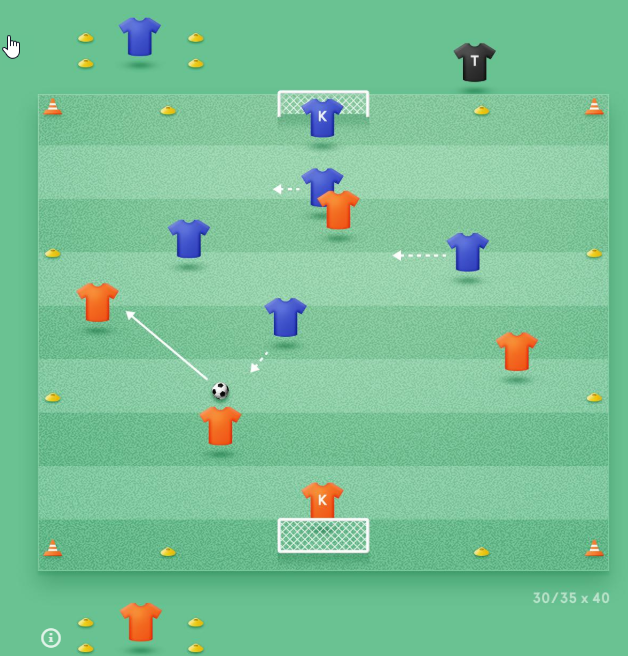Soccer drills for technique passing
- Pairs of two
- One of them rolls the ball and the other passes back.
- the passer runs back and forth between a pilon and the place of passing
- Challenge is to play as much passes as possible in 45 seconds.
Make 4x a square of 10m x15m with 16 players
- 1 player (X) in the middle
- 3 players on the lines of the square with 2 balls
- Player X is played by player A on the corner.
- Player X takes the ball and moves to the other corner of the square and plays player B.
- Player A on the corner runs to the next corner.
- After this player D plays in on X who then takes the ball open again and passes on.
- What follows now is a kind of carousel.
- The ball always goes crosswise, from one corner to the other.
- Variation in this is to play the other way around.
- Player X controls the ball with his right foot and turns and then continues to pass with the left foot.
- Make sure you stand lightly on the forefeet here.
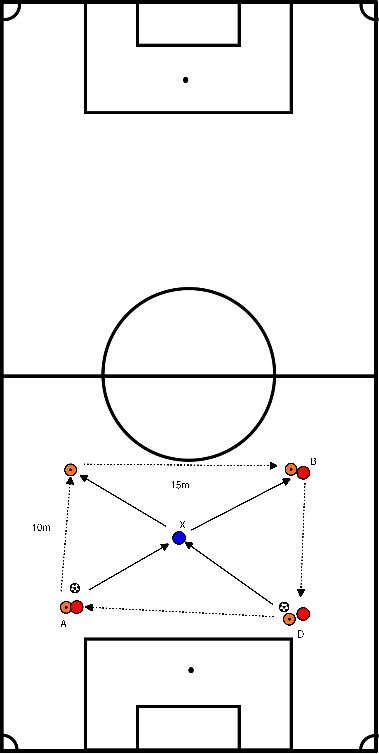
- Player plays the ball in the feet of a fellow player, this player plays the ball back.
- Player runs in on the ball and plays on the second player who is on the 16 metre line.
- This player also plays the ball back.
- First player runs in and shoots at goal
- Always make a feint move.
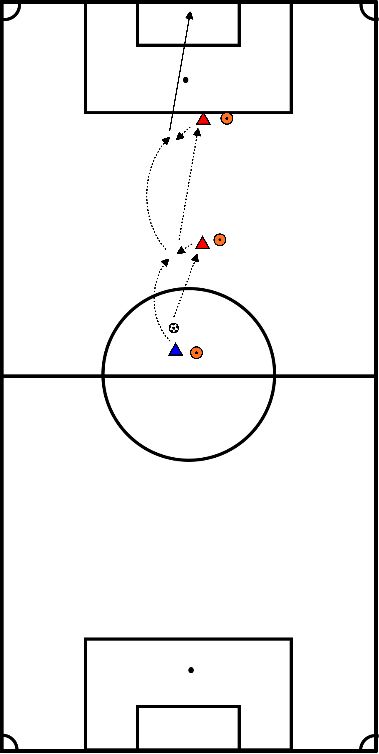
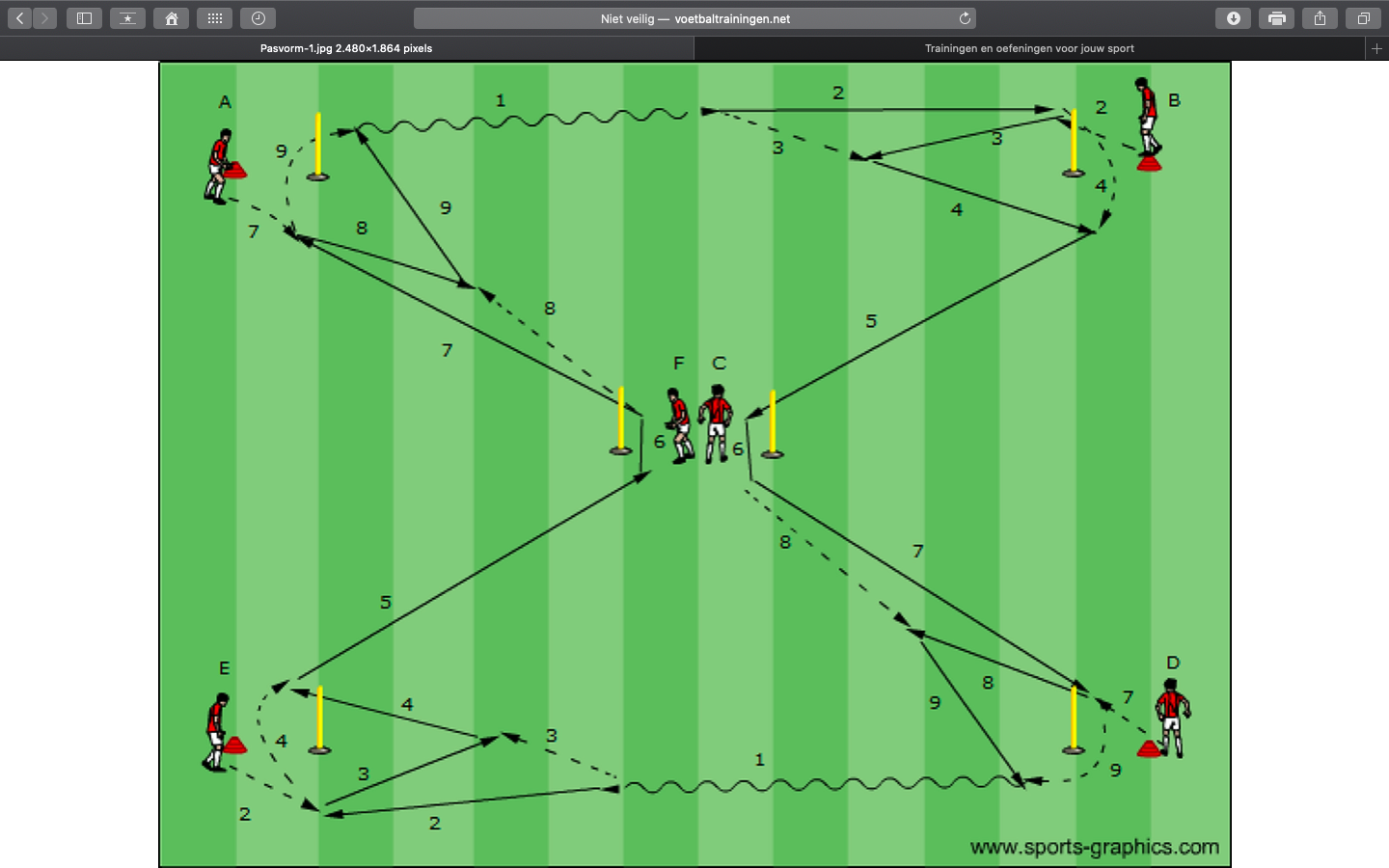
- Players A and D start by leading the ball to players B and E (1),
- The latter make themselves playable next to the stick on which A and D play the ball (2).
- B and E play the ball back (3) on which A and D pass the ball again (4).
- Then B and E play the ball on C and F (5).
- Doing a good control of the ball behind the stick (6)
- After that. they're going to finish on target.
- After finishing, they're going to get the ball and connect in the back.
- Defense to attack in a 1-4-4-2.
- Here the running forms of the attack and defence are important.
- Form 2 of the 2 where the focus is on the outfielder 7/8 creates space for the 2/5 .
- Here the 6 of the bb game is used to give the through ball
- The exercise can be done without or with defense.
- It is important that they do not play the ball directly on the 7/8 from the moment they own the ball.
- First move the ball for some time between 3->4 4->5, where 5 gets up high as soon as the ball goes from 2 to 3.
- When 5 receives the ball not directly to the 8 games but first back to the 4.
- From 4 to the 3 and from 3 to the 2.
- Let the defense get through the right running lines at the right time before they play the ball to the 7/8.
- As soon as the ball goes from the 2 to the 7, pay attention to the correct running lines of the 7.
- Creating space for the 2 is done by letting the 7 get into the ball and bouncing the ball to the 6.
- After the bouncing from the 2 to the 7 the 2 have to make a running action in the depth.
- The 7 plays the ball on the 6 that comes under the ball.
- The 6 then plays the ball deep on the 2 with the 9 running to the first post, the 11 diagonally behind the 9 and the 8 around the second post in a line behind the 11 and 9.
- 10 comes on the 16 meter line and the 7 diagonally behind the 2.
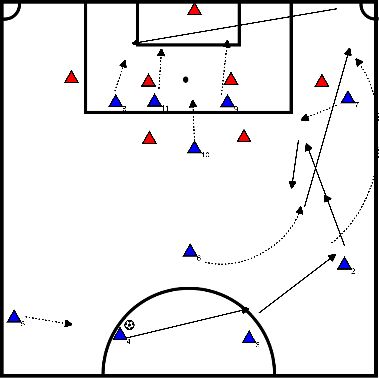
- In the following exercises it is important that the players keep moving.
- A fast circulation of the ball is important.
- When acting didactically, you can add resistance for the players if the exercise is carried out correctly
- A third variation within this exercise is letting the players choose for themselves
- The player 8/7 together with the 6 and the 10 make the choice between variant 1 and 2.
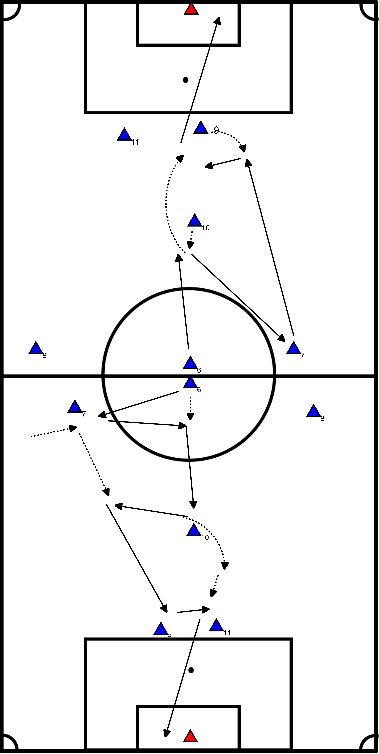
- Exercise that can be used to practise short and long passing
- Advanced players can play in one time
- Each player moves to set up a 1-2
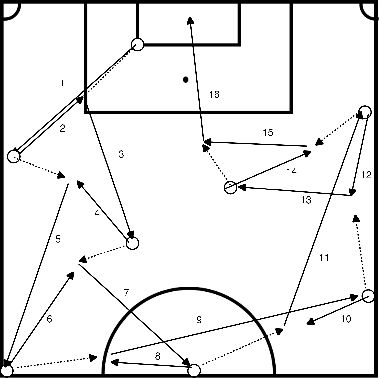
- 1 passes to 2
- 2 passes back on 1 and 1 plays on 3
- 3 passes back on 2 and 2 plays on 4
- ...
- 6 passes back on 5 and 5 plays in depth on 6
- 6 finishes off, gets the ball and joins the line

- The following exercise contains a lot of speed, agility, coordination, passing and even duelling.
- A speed exercise that can be done at any time of the training.
- Any age group can do this exercise. There are enough variations possible that you can apply yourself.
- With the younger and even the older groups the FUN aspect is also very pleasant.
- You can apply this form of exercise to different distances. It is especially important to look at your age group and what you want to achieve.
- Both players A leave with shoulder to shoulder until they're between the poles.
- (1), They then accelerate around the pilon and go back to the stick
- (2,3). Behind the stick, they go sideways over the hurdles
- (4). Again they go behind the stick and accelerate forward to the stick that's the furthest away.
- (5). Back to the other pole again
- (6) to then get a ball played in from B
- (7) on which A finishes on target
- (8).Player who finishes first wins.
- In the older ages you can have the loser do push-ups or do an extra job.
- At younger ages you add up the points.
- A takes the place of B and B goes to A.
- As a variation, you can have players B throw up the ball so that A has to head the ball inside the goal.
- As you can see, it is all about speed, agility and coordination
- Whoever wins, it's always fun and hard work is done
- Have fun with this speed exercise and let us know what you thought of it
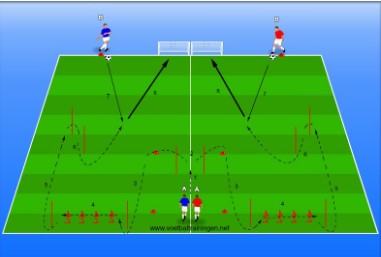
- Scoring by shooting / passing towards a pilon
- Controlling a rolling ball in front of or on the line
- Good first touch (keep the ball under control)
- Pass with inside foot / instep towards the pilon
- Choose position to receive the ball
- Make sure that you pay attention not only to the player who is passing, but also to the player at the other side that has to control the ball
- An alternative may be not to work with individual scores, but with a score per pair. The couple that gets the most points wins
- Scoring by dribbling across the goal line
- Playing out of the situation through good positional play
- Ball control in the positional play
- Act fast, be able to pass directly
- Keep an overview of the situations for moving the game and choosing the moment and direction of the passing action
- Cutting off the opponent's pass and keeping them off the ball
- Coaching defenders to cut the line off the pass
- Defenders coach on giving coverage (standing diagonally behind each other)
- Both teams can score in a big goal
- When the ball is out, dribble or play the ball back in play
- Whenever a goal is scored, goal kick or corner kick, the goalkeeper starts his own goal.
- (Possibly) substituting after every goal, goal kick or corner kick
